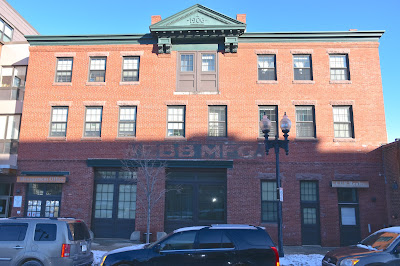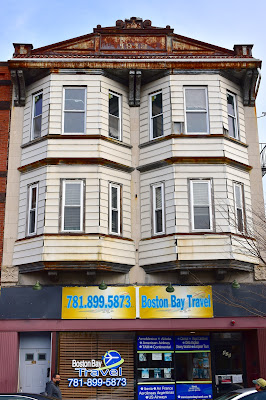From That Same Old Guy:
Recently I explored a bit of Manchester, Connecticut, a town about half an hour from where I grew up, but that I knew next to nothing about (see April 30, 2022, "Mr. Paranoid Visits an Old Mill"). Named after Manchester, England, this Connecticut burg is known as Silk City, due to its past as a textile town. That's a good nickname, although perhaps not as good as its like-named city in New Hampshire, which is known as Manchvegas, or even the originator in Jolly Old England, which some call Madchester.
Anyway, in this post, I will feature the main commercial drag, which features a lot of cool old buildings, murals and even a ghost sign, and a few other points of interest.
I'm gonna go from A (ADT) to Z (Zipser).

Located on Purnell Place, just off Main Street, this ADT burglar alarm threw me for a loop. I thought ADT was a newfangled security company, but it turns out the company was founded in 1874, in Baltimore, as American District Telegraph. According to the company's web site, it "pioneered the concept of the Central Monitoring Center, enabling thousands of customers to link to 24/7/365 monitoring and protection," in the period between 1920 and 1940. The company also claims to have been the first to launch an automated burglar system.
As you can see, this old alarm box is at the edge of a work of art. More of it is seen below.

This great mural was done by Ben Keller, who has painted murals all across the Nutmeg State.
Below is a doorway on a side street.

I'm not doing this in an entirely alphabetically honest fashion, for which I apologize. Below is the Dilworth-Cornell-Quey Post 102 of the American Legion.


I hope that good-looking sign lights up at night.
Below is a ghost sign on the side of a John Boyle Decorating Center.

The sign says, in part, "PAUL'S PAINT." Google Maps still shows this business as Paul's Paint & Decorating Center.
Whenever I'm walking along a street with old commercial buildings that go back 100 years or more, I look for entryway ghost signs. I saw just one along Main Street.

Grants was a department store chain founded by William T. Grant in 1906. "In 1906 the first 'W. T. Grant Co. 25 Cent Store' opened in Lynn, Massachusetts," according to Wikipedia. "Modest profit, coupled with a fast turnover of inventory, caused the stores to grow to almost $100 million annual sales by 1936, the same year that William Thomas Grant started the W. T. Grant Foundation. By the time Grant died in 1972 at age 96, his chain of W. T. Grant Stores had grown to almost 1,200."
Four years later, the company went out of business. "W. T. Grant's bankruptcy in 1976 which was the then-second biggest in US history, was in part due to a failure to adapt to changing times but was probably accelerated by management's refusal until it was too late to eliminate the shareholder dividend," Wikipedia continues.
On July 13, 2020, I ran a post about East Boston that features another old Grants store, this one with the name carved into the facade.
Below is the former State Theatre, which opened in 1925.

As I've mentioned before, I often do research on Google Street View before visiting a neighborhood, village, town or city. This is important work, as it allows me to keep to maximize the often limited time that I have to explore. This method, however, also sometimes robs me of the surprise of finding places like the Full Gospel Interdenominational Church on Main Street.

I knew this fantastic sign, using the theater's old marquee, was here, but I was still stunned to see it in person. This just isn't something I come across very often in my travels around New England. "The State Theatre on Main Street in South Manchester was opened in June 1925. It was operated by Warner Bros. in the 1940’s. It was given a make-over in 1941," according to Cinema Treasures. "It was sold to a church group in June 1974 and is now the Full Gospel Interdenominational church, which according to the marquee, is open 24 hours."
The Tinker Building, below, was built in 1911.

This space is currently occupied by Market on Main and Jeicoby Scott Salon.
Below is the side of Urban Lodge Brewing on Purnell Place.

The brewery has a cool outdoor space and an amazing mural on the rear outside wall.
Speaking of cool murals....

This one is down an alley off of Main Street, on the side of Work Space Manchester, a co-working and gallery space.
Lastly, we come to the letter "Z," for the Zipser Club, which is located on Brainard Place.

"The Zipser Germans or Zipsers are a German-speaking (specifically Zipser German-speaking) ethnic group which developed in the Szepes County of Upper Hungary — today mostly Slovakia — as that region was settled by people from central Germany beginning in the 13th century," according to Wikipedia. "Beginning in at least the 18th century, many members of the ethnic group migrated to southern Bukovina, Maramuresch, and Transylvania (today in Romania)."
A Google search for "Zipser Club" turned up only information about this one. Is this the only such social club in the United States that feels kinship with former Slovak President Rudolf Schuster, who is partly Zipser German?
Make sure to check back soon for a post about my second stroll through Silk City.

















































